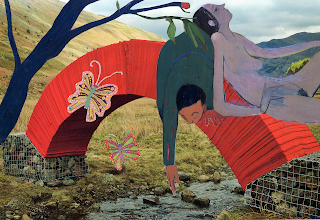A friend posted on Facebook, “What is something you've done
that you're pretty confident you're the only person on my friends list to have
ever done?” The responses flooded in with many amazing things such as:
“I once told Steven Spielberg, to his face, that I didn’t
like ET as a kid.”
“Tara Reid once threw a LIT cigarette at me.”
“I waited on Adam Arkin.”
“Shook hands with Pope John Paul II.”
“Attended a callback for Cirque du Soleil as a ventriloquist.”
And “Dressed up as an electric fence for Halloween. (Wrapped
myself in silver ribbon and carried a stun gun).”
I posted that I once hugged Tipper Gore and ate dinner in
the same restaurant and at the same time as the Chicago Bulls—at least a group
of their players including Scotty Pippin and Luc Longley. I’ll elaborate on
that and at least one other memorable moment.
When I was in junior high school, I was voted Homecoming
King. It was clearly a sympathy vote because I had been injured playing
football and was confined to a wheelchair. But at halftime of the game against
our rival, Laurel, I was pushed out to the center of the field in a wheelchair—fifty
yard line, pushed by my identical twin brother who was in uniform (he was on
the team) and accompanied by my queen, Kay Beard, with whom almost every boy in
the school had a mad crush. Including me. After we were crowned, Kay leaned
over and kissed me. Oh boy!
Three years later, another homecoming game against the same
rival, but this time in high school. I was not Homecoming King, nor was I on
the team. My knee injury never healed sufficiently for me to play again. But my
twin brother was on the team. He was the smallest boy on the team. Laughably small
for football. Probably the smallest boy ever to play for the Hattiesburg High
Tigers. Normally he was a backup running back, but in this game, for reasons I
can’t recall, he was put in as a defensive back forced to cover, at five-foot-three,
a six-foot-tall wide receiver. And late in the fourth quarter he made a
miraculous leap to intercept a pass and run it back sixty yards for the winning
touchdown. It was my moment of glory as well as his, because back then my twin
and I thought and acted and felt as one person.
Fast forward to 1996. We were at a PFLAG gathering in
Seattle on the same night that the World Champion Chicago Bulls were playing
the Seattle Sonics. After our meeting and after the game we went to a hotel
restaurant for a late dinner. The Bulls’ team bus pulled up as we were parking,
and the players unloaded and went into the hotel. I remember seeing Luc
Longley, center, seven-feet tall, duck to go through the door. A group of the
players came into the restaurant while we were eating. The great Michael Jordan
was not with them. The restaurant was full, and they had to wait for a table. I
overheard Scotty Pippin say to one of his teammates, “If Michael was with us we
wouldn’t have to wait.”
I’ll bet he was right.
Four years later we went to Washington D.C. for a PFLAG
conference and the Millennium March on Washington, a march for LGBTQ rights.
Naturally, we didn’t know anyone else on the airplane except for one other
person from Olympia. When the airplane got to D.C. and the pilot announced we
were preparing to land, he said, “If you’re going to the Millennium March, have
a great time,” and the entire plane erupted in cheers. Everyone on the plane
was going to the march, and suddenly it was as if we were all old friends. And
in the city it was as if all the people in D.C. were old friends. I had never
in my life seen so many rainbow flags.
I can’t remember the exact sequence of events,
but there was a dinner and a keynote speaker, and entertainment by our friend
Steve Schalchlin,
who sang for the first time in front of an audience “Gabi’s Song,” a song he
wrote about our son Bill who committed suicide after a gay bashing. It was such
a wonderfully sad moment, and Gabi and I were smothered with support.
The line filed past her, and everyone in their turn said hello and
thank you, and Gabi whispered to me, “When it’s our turn, I’m going to tell her
about Bill.” And she did. And when she did Tipper Gore reached across the line
and gave each of us a big hug. You know, I knew hardly anything about her
except she was married to the vice president and had headed up some silly
campaign against profanity in music. But that moment—Wow! I felt like I imagine
that person who said they shook the pope’s hand must have felt.
















